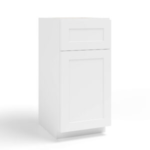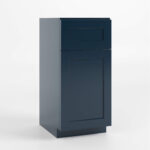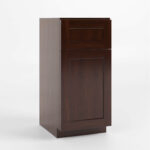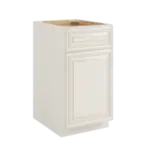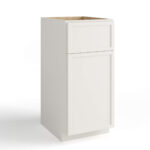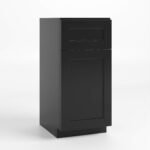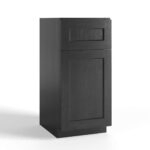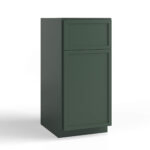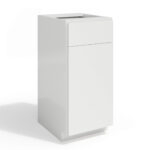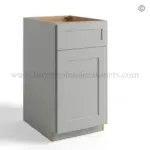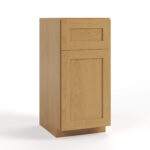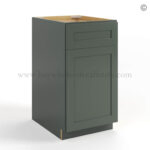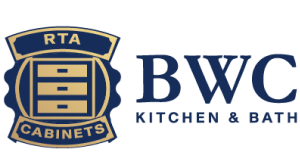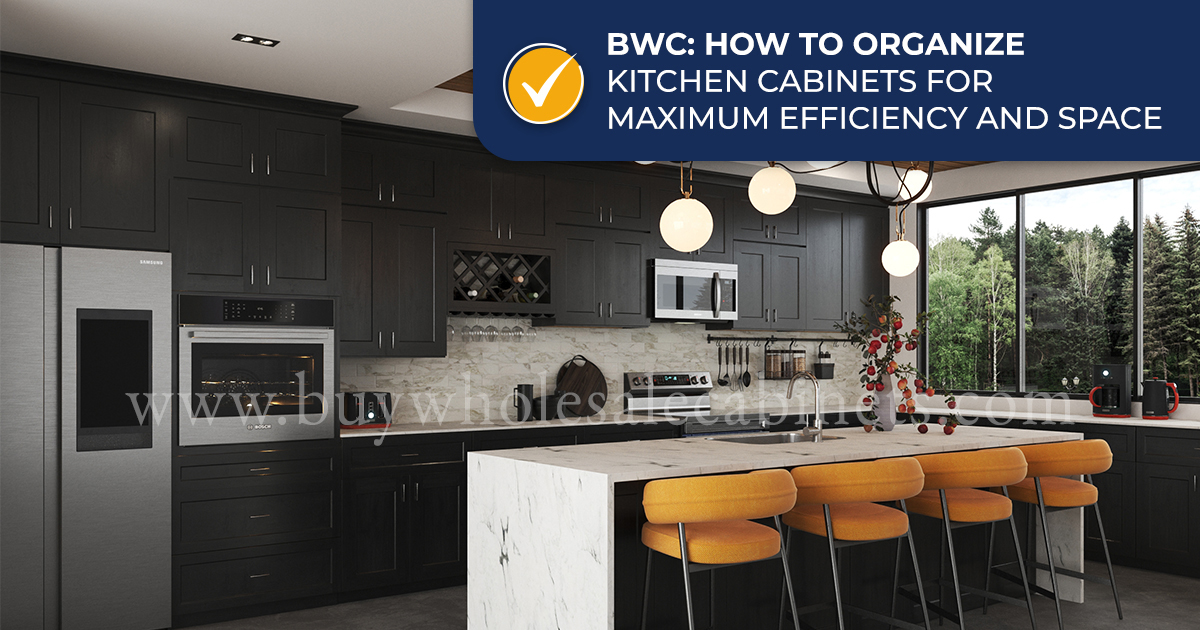Table of contents:
- Introduction
- Assign a specific function to each RTA cabinet
- Place frequently used items in visible spots
- Use organizers to keep items neatly arranged
- Regularly clean your RTA cabinets
- Conclusion
Summary
Tired of rummaging through unorganized kitchen cabinets? This blog will provide you with insights into how to clean, maintain, and optimize the space in your cabinets. By the end of the guide, you will learn the tricks behind keeping your cabinets neat and functional.Introduction to Organize Kitchen Cabinets
Once you have chosen the RTA cabinets that suit your needs, the most important step follows – how to organize kitchen cabinets. A clean and tidy kitchen is half of good health – this is often said by those who spend the most time in the kitchen. The key steps in the process of organizing kitchen cabinets are to get rid of things you no longer need and consider purchasing organizers that will help you keep your items always within reach.
These are just a few guidelines for the best organization of your RTA cabinets. Buy Wholesale Cabinets offers not only high-quality and affordable RTA cabinets, but also solutions for the best organization in your kitchen. Get ready for the best tips on how to organize kitchen cabinets and add a new shine to your kitchen!
Assign a specific function to each RTA cabinet
As with any other task, when it comes to the problem of how to organize kitchen cabinets, preparation and a good PLAN are crucial. We can consider the plan as half of the work already done. In creating this plan and organization, you can involve other household members, but if you are the one who spends the most time in the kitchen, it’s best if you are the one to make the plan you will follow.
What should be included in the kitchen organization plan?
So, you’ve ordered RTA cabinets from Buy Wholesale Cabinets and selected the right number of wall cabinets and base cabinets based on the size of your kitchen. That was the first step. After that, you’ve successfully assembled and installed your RTA cabinets. If you’re still unsure about assembling RTA cabinets, check out our guide on how to install shaker cabinets to ensure you don’t make any mistakes.
Once you’ve done all that, it’s time for your important task: deciding which kitchen cabinets will be designated for storing specific items. In other words, you need to assign a role to each kitchen cabinet.
Here’s the list for your “How to organize kitchen cabinets” plan:
Dishware and Baking Equipment
Assign specific cabinets for pots, pans, baking sheets, and bowls, ideally close to the stove or oven for quick access. It’s best to place these in base cabinets located right next to the stove. For example, in base cabinets with double doors, you can store all the pots, pans, and skillets you use most often. This way, everything will be in one place and immediately accessible.
Spices and Condiments
Plan a small cabinet or drawer near the cooking area for spices, oils, and seasonings to keep them organized and within reach while cooking. A drawer base cabinet works great for this. In the first drawer, you can store the flatware you use most often for meals, while in the second, slightly larger drawer, you can neatly arrange your spices. The second drawer of the drawer base cabinet offers more space than the first, so you’ll be able to organize everything nicely.
Pantry Storage
For non-perishable items like canned goods, pasta, and rice, assign a larger cabinet or a dedicated pantry space. Organize them by categories for easier access. Storing in pantry cabinets can be a bit more involved than organizing other kitchen cabinets. Pantry cabinets are known for their height, which can extend to the ceiling. Therefore, you need to consider what items you’ll place at the very top of the pantry cabinets.
Cleaning Supplies
Reserve a cabinet under the sink for cleaning supplies, sponges, and trash bags, ensuring they are organized and out of reach of children if necessary. Farmhouse sink cabinets are an ideal solution if you want to keep all your rags and cleaning supplies in one place. They offer plenty of space, and all your supplies will be visible.
Small Appliances
Assign space for small appliances (e.g., mixer, toaster) in cabinets that are out of the way but accessible when needed. It’s best to place small appliances in base cabinets. We recommend using Easy Reach Base Cabinets or Base End Cabinets for this purpose.
Items for Special Occasions
For items used less frequently, such as serving dishes and holiday china, choose cabinets that are more or less accessible. The upper section of Pantry Cabinets is the ideal place for this.
Place frequently used items in visible spots
We know that for those who spend the most time in the kitchen, it’s important to have items within easy reach. Think about what you use most often: spices, cookware, flatware, towels, trivets, and so on.
Don’t hesitate to place frequently used items on the countertop of your kitchen cabinets so that they are always visible. A good kitchen organization and plan for “How to organize kitchen cabinets” will enable you to quickly access everything you need without having to search or open every single cabinet.
Wall Kitchen Cabinets
In our guide on How to organize kitchen cabinets, we want to cover all areas of the kitchen. So far, we’ve focused on base cabinets, but we mustn’t forget the importance of wall kitchen cabinets.
In wall kitchen cabinets, you can arrange the mugs you use most often. Place the mugs you like best and drink from most often at the front of the RTA cabinets. Those that are used less frequently can go toward the back.
You can also store dishes like plates and bowls, whether ceramic or plastic, in wall cabinets. Our advice is to separate shallow and deep plates and place them on different shelves in the wall cabinets, making it easier to find the plate you need.
Open Shelves
If you have enough space in your kitchen, open shelves can be a great way to display frequently used items that aren’t too aesthetically demanding. You can use these shelves to store spices, yeast, olive oil, salt, and other seasonings or ingredients you’ll need while cooking.
Use organizers to keep items neatly arranged
The use of organizers, both in the bathroom and in the kitchen, has become very popular recently. There are organizers of various sizes and materials, and they can be purchased in almost any supermarket.
Organizers can greatly help with organizing items inside drawers. They are perfect for keeping things in place and allowing you to quickly find them without overcrowding the space.
How to organize kitchen cabinets with organizers
Drawers are the perfect space for organizing smaller items such as flatware, measuring spoons, sponges, napkins, and even spices. Use divided drawers to create sections within the drawers, making it easier to access items and reducing clutter. For example, dedicate one section just for teaspoons, forks, and knives, while in another, you can store small appliances or baking equipment.
For spices that are used daily, you can also use specialized spice racks. Multi-level racks allow you to have a clear view of all your spices while keeping them neatly organized. If you don’t have much space in your kitchen, vertical racks with shelves can be a great way to save space and keep your spices within easy reach.
Organizers help make organizing kitchen cabinets an easy and enjoyable task.
Maximizing Corner Cabinets and Hard-to-Reach Spaces
Keeping your kitchen well-organized not only makes it more functional but also keeps the space more efficient and stress-free. But when it comes to the tricky corners and hard-to-reach spots in the upper cabinets, you may have to get creative to utilize the space efficiently.
Installing Lazy Susans
A Lazy Susan is a brilliant invention for accessing items tucked away in the back of the corner cabinets. You can simply spin and easily access forgotten jars. That way, you don’t have to empty the entire cabinet to reach the forgotten items.
Pull-Out Drawers and Trays
Pull-out drawers and trays are perfect for narrow or deep cabinets. Ideal for storing pans, pots, and cleaning supplies, these units are user-friendly and provide a clear view of all items at once.
Vertical Storage for Tall Items
Maximize your cabinet height by installing vertical racks or dividers to keep cutting boards, trays, and cooking sheets neatly organized. They save space and make it easier to access utilities during cooking or baking.
Each of these storage solutions has a specific purpose. To help you pick the proper storage for your cabinet, here’s a quick comparison of the three options.
| Storage System Type | Suitable For | Key Advantages |
| Lazy Susan | Corner cabinets | Easy rotation improves accessibility |
| Pull-Out Drawers and Trays | Deep cabinets | Offers full visibility |
| Vertical Dividers | Tall cabinets | Maximizes storage space |
Regularly clean your RTA cabinets
Regular cleaning of RTA cabinets is essential to maintain the hygiene of your kitchen cabinets daily. In addition to good kitchen organization, hygiene is also very important. Regularly cleaning your kitchen cabinets not only ensures cleanliness but also helps you keep track of the condition of your RTA cabinets after, for example, a week’s use.
During cleaning, you can review what is inside your cabinets and identify items that are no longer needed or are damaged. For instance, you may notice duplicate spices, broken appliances, or empty boxes that are taking up space. Regular cleaning also allows you to reorganize items in the cabinets, allowing you to maximize every bit of available space.
If cabinet space is not regularly cleaned, it can lead to the accumulation of items that make it harder to maintain organization. Regular cleaning ensures that the organization remains intact, as you’ll have the chance to rearrange items according to your needs, making them easier to access.
Tips for Maintaining an Organized Kitchen Cabinet
You have completed the hard part, organizing your kitchen cabinets. Now the main test begins: maintaining everything in that state. Keeping cabinets clean becomes much easier when you change your habits around how you use and store things every day.
Declutter Regularly
Hoarding leads to clutter. Conduct a quick sweep every month to discard expired items, donate excess products, and keep track of items suitable for use.
Group Similar Items Together
Whether you are a baker or a cook, divide “zones” for your tools, snacks, and spices to keep things organized. You can group all the baking items and store them in the “baking” zone, and follow the same trick for organizing the spices, snacks, chocolates, and more.
Use Clear Containers and Labels
Transparent storage jars and containers can make it easy to find things without even opening the lid. You can also label them with dates for items with limited shelf lives to limit waste and overbuying.
Maximize Vertical Space
Add hooks, stacking shelves, or tiered racks inside the cabinet doors to increase space. Vertical storage systems are an excellent solution for maximizing storage space and keeping jars, plates, and pantry items neatly separated and organized.
Adopt a ‘First In, First Out’ System
The ‘First In, First Out’ system is an effective way of reducing waste and keeping your pantry fresh. When restocking, always place the newer items behind the older ones. That way, the older stock gets used first, so nothing gets lost in the back cabinets.
Conclusion
For your “How to organize kitchen cabinets” project to be as successful as possible, it’s crucial to have a plan to guide you during the organization process. Once you establish good kitchen organization from the start, it will be much easier to maintain the system you’ve created in the future.
Don’t wait any longer – start organize kitchen cabinets now and enjoy a functional and tidy space! Use the tips from Buy Wholesale Cabinets and create a space that will make your kitchen cabinets organized!
FAQs
What is the best way to organize kitchen cabinets?
Here’s what you should do to keep your kitchen in order:
- Don’t hoard items. Sort everything into categories such as “keep,” “toss,” and “donate.”
- Clean the cabinets with a mild soap solution before restocking.
- Zone your kitchen and keep the cooking utensils within your reach.
- Use cutlery trays to separate spoons, forks, and knives.
- Use stackable containers and shelf inserts in the cabinets to increase your storage space.
- Store the seasonal items in the upper cabinets and the heavier cookware in the lower cabinets.
- Install hooks on the inside of the cabinet doors to hang cleaning cloths, measuring spoons, and other small items.
- Divide your cleaning routine into weekly, monthly, and quarterly tasks. For instance, make wiping down shelves a weekly task, reorganizing drawers and checking for expired items a monthly task, and deep cleaning cabinets a quarterly task.
How do I decide which items go in which cabinets?
You can follow this simple mechanism to determine where each item goes in the cabinet.
- Declutter the cabinets and categorize them.
- Group the items according to “frequently used,” “less used,” and “rarely used.”
- Store daily items in the eye-level cabinets for easy accessibility.
- Place large cookware, pots, and appliances on the lower cabinets to stabilize the weight.
- Use upper cabinets to store lighter items, such as glasses, mugs, canned goods, and spices.
- Store silverware and cooking utensils in the drawers. Baking supplies, spices, and pans are suitable for deep drawers.
What are the most efficient cabinet layouts for small kitchens?
L-shaped, U-shaped, one-wall, and galley designs are popular cabinet layouts for compact kitchens. L-shaped cabinets are suitable for open-plan living, while U-shaped ones are ideal for maximizing counter and storage area. Galley cabinets are suitable for narrow, linear spaces, while a one-wall cabinet layout is perfect for tiny spaces.
How to arrange dishes in kitchen cabinets?
To arrange your dishes in the cabinets:
- Declutter and categorize them into “heavier items,” “frequent use,” and “infrequently used items.”
- Create “zones” for cooking, baking, and everyday dishes.
- Store regular-use plates, glasses, bowls, and cups in cabinets closest to the stove and the dishwasher for quick access during meal prep.
- Keep infrequently used items in the back of the top shelves.
- Place the heavier dishes or large serving platters on lower shelves.
How should clean single-use utensils be stored?
Store your clean single-use utensils in a clean, moisture-free place, adequately packed in their original packaging to protect them from damage and exposure to dirt and moisture. Ensure the lower platforms are at least 2 inches elevated from the ground to prevent contamination. Most importantly, keep your utensils away from chemical or cleaning supplies to avoid cross-contamination.
